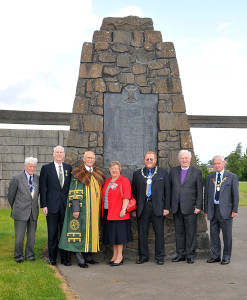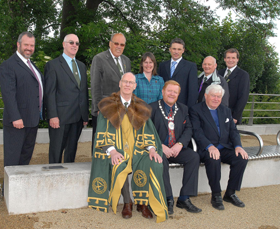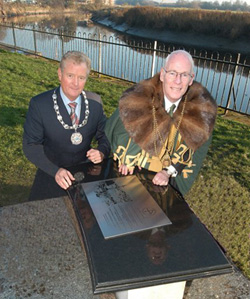In 1985 the Brethern decided that they should increase the value of the Guildry to the community. In spite of their antiquity and unlike the City Guilds they had never amassed funds either from legacies or elsewhere and only gained the reputation of a charitable organisation at second hand from pensions to the decayed brethren from the generosity of John Cowane three hundred years earlier.
A Trust Deed was prepared and approved by a Court of the Guildry on 15 August 1984. The Trustees are the Dean and the Clerk of the Guildry of the time and the purposes are:-
“The Trustees shall hold the Trust Fund for charitable purposes (in the sense in which that expression is used in the Income and Corporation Taxes Act, 1970 or any re-enactment there of) in the United Kingdom and with the consent of the Dean’s Council of the said Incorporation shall pay or apply the Capital and Income to any charitable bodies, organisations and associations or individuals qualifying for charity in the United Kingdom which the Trustees shall select and that in such amounts or at such times and in such instalments as the Trustees may in their absolute discretion think proper”
Special Projects
Since the creation of the trust deed, the Guildry has initiated a number of charitable projects. These include:
- An annual History prize, known as the The Guildry History Prize is awarded to the High Schools in the Stirling Council area with £100 worth of book tokens for each school to be divided equally between their number of History Prize Winners.
- The following books were partially financed by the Stirling Guildry:
Talking Headstones – a book on prominent people from Stirling who are buried at the Top of the Town
Discover Old Stirling – a junior book walking you through Old Stirling.
The Guildry produced a video called “A Window on History“
The Guildry have presented the Smith Art Gallery and Museum in Stirling with a replica Guildry Ring which is now on display with other Guildry Items
The Historic Cairn at the Bannockburn Monument
The Historic Cairn at the Bannockburn Monument was rededicated on 18th June 2008 – 51 years after the original ceremony. The service was conducted by the Rev. Ian Paterson. The Lord Lieutenant Mrs Marjory McLachlan, Provost Fergus Wood, members of the Seven Incorporated Trades, Guild Brothers including the late Willie Scott who was present at the original ceremony in 1957 were among the group at the service. A suggestion was made by Joseph Dickson at a Guildry supper in 1954 that there was no fitting and lasting memorial to commemorate the 1314 victory and preparations for the building and financing of the Cairn at a cost of £500.00 were started. This sum was part funded by The Guildry of Stirling together with subscriptions from local residents and from Scots at home and abroad. The Stirling Observer played a major part in generating interest in the project and created a “shilling fund” for local donations. The 15ft high Cairn was built by Hooks and Mallon of Doune using stone from Cambusbarron quarry. The bronze plaques were made by WK White of Edinburgh and the final cost was £770.00. Present at the unveiling ceremony of the Cairn on June 1957 were Dean of The Guildry John M Hay, Provost David Duncan, John Blyth Deacon of the Seven Incorporated Trades and the Rev. David Dick who gave the prayer of dedication.
Fifty one years later, the Dean of the Guildry of Stirling at the time, Ian Crawford, said:
“The Historic interest in this memorial continues to attract even increasing numbers of visitors from around the world. The Battle of Bannockburn has come to be regarded as synonymous with freedom.”

Those attending the re-dedication ceremony in the picture (from left to right):
Tom White Past Deacon of the Skinners.
Alan Webb Past Dean of the Guildry
The late Ian Crawford Dean of the Guildry
Lord Lieutenant Mrs Marjory McLachlan
Provost Fergus Wood
Rev. Ian Paterson
Stewart Forsyth Deacon Convener of the Seven Incorporated Trades
The Guildry of Stirling Dux Medal
In 2007 the Guildry of Stirling agreed to sponsor a Dux Medal for Bannockburn High School. The Medal and presentation box were designed as a joint project by the School and the Guildry. The medal was struck by The Tower Mint in London. The face of the medal shows the School Crest and engraved above it are the words “The Guildry of Stirling” and below the crest the words “Dux Medal”. The reverse of the medal has a laurel leaf motive round the outer edge with sufficient space for the recipients name and date. The silk screen in the lid of the presentation box has the Guildry symbol, the reverse 4 and the words “Presented By The Guildry of Stirling Instituted By Alexander 1st in 1119”. The Medal is gold plated and the sponsorship will last for twelve years.
Forthside Seat
 The image shows the “Handover Ceremony” held Wednesday 10th June 2009 to mark the Forthside Development with The Guildry’s donation of £1,000 towards the cost of the bespoke stainless steel top on top of Stirling Council’s concrete bench. A plaque was also installed to record the occasion. The seat is located near to where a new Civic Square will be developed and along the river from where The Guildry donated a granite and marble seat and plaque in November 2005 at the site of Old Stirling Harbour.
The image shows the “Handover Ceremony” held Wednesday 10th June 2009 to mark the Forthside Development with The Guildry’s donation of £1,000 towards the cost of the bespoke stainless steel top on top of Stirling Council’s concrete bench. A plaque was also installed to record the occasion. The seat is located near to where a new Civic Square will be developed and along the river from where The Guildry donated a granite and marble seat and plaque in November 2005 at the site of Old Stirling Harbour.
Sitting (left to Right); Former Dean Alan Webb, Provost Fergus Wood, Reverend Ian Paterson Standing: Mrs Mandy McKirdy, Surveyor at Stirling Ventures accompanied by members of the Dean’s Council; Alasdair Gammack, William Weir, Michael Coleman, Jim Mailer, Tom Sinclair and Ian Carmichael.
The Seat and Plaque
 Guildry Seat and Plaque at Stirling Old Harbour, Riverside Handover Ceremony 1.45pm Tuesday 22 November 2005 The Merchant Guildry of Stirling was instituted 1119 and was a powerful organisation involved in running the town until the Burgh Reform Act 1833 and Burgh Trading Act 1845 provided for the election of Town Councils and abolished the privileges of Merchant Guilds. The Guild contributed to the wealth of Stirling through weekly markets and trading with European ports from the early 1400s (Deans of Guild date from 1470 to the present day). Over the centuries goods were brought into Stirling and exports taken to European trading places via ships at Old Stirling Harbour, of which today there is little evidence.
Guildry Seat and Plaque at Stirling Old Harbour, Riverside Handover Ceremony 1.45pm Tuesday 22 November 2005 The Merchant Guildry of Stirling was instituted 1119 and was a powerful organisation involved in running the town until the Burgh Reform Act 1833 and Burgh Trading Act 1845 provided for the election of Town Councils and abolished the privileges of Merchant Guilds. The Guild contributed to the wealth of Stirling through weekly markets and trading with European ports from the early 1400s (Deans of Guild date from 1470 to the present day). Over the centuries goods were brought into Stirling and exports taken to European trading places via ships at Old Stirling Harbour, of which today there is little evidence.
A James Proudfoot drawing in 1972 suggests how the harbour would look circa 1600 with two sailing ships docked against a background of the top of the town and Stirling Castle. During the 19th and 20th Century pleasure steamers and various vessels sailed up the River Forth to Stirling. The current Dean of Guild, Alan Webb, felt it would be appropriate to highlight the site of the old harbour and the Guild have donated a seat on which is placed a plaque with an extract of the Proudfoot scene. Hopefully local people and visitors can sit, enjoy the views and contemplate the history of sailing and its contribution to the growth and importance of Stirling.


